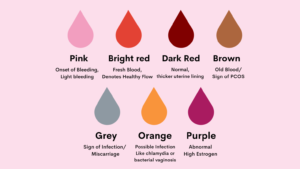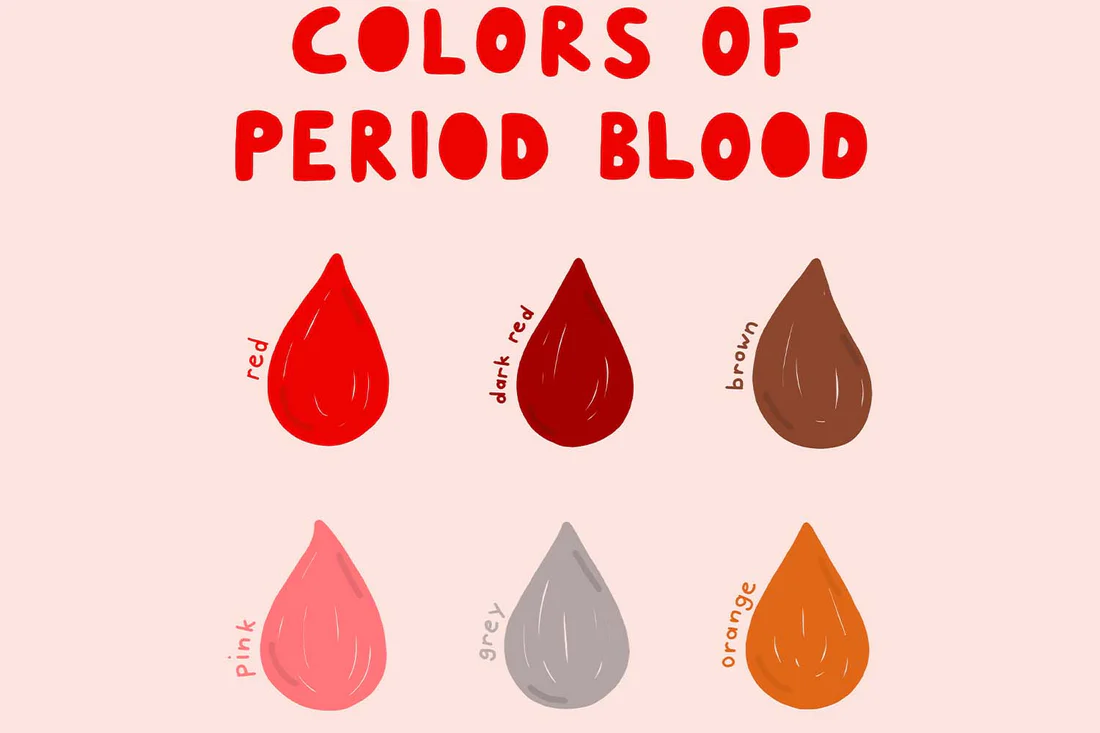What Your Menstrual Blood Indicates and The Colour and Significance of Periods:
Millions of women and people with uteruses go through menstruation each month. The colour and significance of the period can be equally important in understanding general health, even though most people concentrate on timing, flow, and cramps. In addition to being brilliant red, menstrual blood can also be dark brown, pink, or even grey. Every colour variation provides a different perspective on your inside health.
We’ll break down the colour and significance of the period in this comprehensive guide, assisting you in determining what is typical, what might be concerning, and when to consult a physician.
Recognising the Colour and Significance of Periods

In terms of the meaning and colour of periods, many people are shocked to hear that the colour of menstrual blood can convey many health indicators. A mixture of blood, vaginal secretions, and tissue expelled from the uterine lining makes up menstrual blood. Its appearance can vary according on your health, hormone levels, and cycle stage.
You can identify illnesses, hormone abnormalities, and even early pregnancy symptoms by understanding the colour and meaning of your cycles. Let’s examine the possible meanings of each colour.
Healthy and Active Flow of Bright Red Period Blood
Bright red is frequently seen as an indication of a stable and healthy flow. This typically shows up when the bleeding is at its worst, at the start of your period. Bright red indicates the following in terms of period colour and meaning:
- an ongoing, vigorous loss of the lining of the uterus.
- normal hormone production.
- very little clotting.
Bright red blood throughout your cycle usually corresponds to a regular menstrual cycle. You might want to talk to a doctor about it, though, if bright red blood comes outside of your regular cycle.
Older Blood: Dark Red or Brown Blood
Dark red or brown blood is one of the more popular explanations for the colour and meaning of this time. Usually, this happens near the start or finish of your menstruation. It indicates:
- It has taken longer for the blood to leave the uterus.
- Its colour has darkened due to oxidation.
- Your cycle naturally includes it.
Additionally, this colour may appear following minor bleeding or missing periods. Consistently having brown blood outside of your period, even if it’s usually normal, could be a sign of a hormonal imbalance.
Blood with orange or rusty tints: Be on the lookout for infections.
Problems might come up if your blood is orange or rust in colour, particularly if it is accompanied by discomfort, itching, or an unpleasant smell. This could imply the following in relation to the colour and meaning of the period:
- combining cervical mucous with blood.
- a potential infection, such as a sexually transmitted disease or bacterial vaginosis.
- Very little bleeding occurs throughout the early stages of the cycle.
See a doctor if the orange colour persists or if you experience any symptoms, such as pain or odour.
Pink Period Blood: Light Flow or Hormonal Changes
Pink blood is another variant on the colour and meaning of menstruation. Pink menstrual blood frequently shows up during light spotting or at the beginning or conclusion of a period. This shade could indicate:
low amounts of oestrogen.
recently lost a substantial amount of weight.
Hormonal birth control or the perimenopause.
detecting ovulation.
Pink blood is usually not a cause for concern, but if it continues each cycle, it may be a sign of hormonal imbalances.
Discharge of Grey Blood: Medical Concern
Grey or off-white discharge along with blood is one of the most alarming indicators of menstruation colour and significance. This might indicate:
- an infection caused by bacteria, such bacterial vaginosis.
- a potential miscarriage if there are cramps and significant bleeding.
- an unbalanced vaginal environment.
You should contact your healthcare professional right away if you notice any grey tissue or clots, especially if they smell bad.
Are Menstrual Blood Clots Normal?

Period blood can occasionally be accompanied with clots, especially on heavy days. When examining the colour and significance of periods, clots may show:
- a more substantial flow.
- slower uterine lining shedding.
- uterine fibroids are big and common.
Usually, little clots are normal. However, recurrent large clots (larger than a quarter) may be a sign of a more serious problem and should be evaluated by a doctor.
Colour and Significance of Periods at Every Age and Stage of Life
Age, stage of life, and hormone variations can all affect the colour and meaning of the period:
- Teens: Uneven hormones might result in uneven colour and flow.
- Menstrual periods tend to be regulated in the 20s and 30s, however flow and colour can be affected by stress and contraception.
- Pregnancy/Postpartum: In the early stages of pregnancy, spotting or brown discharge may occur. “Lochia” turns from brilliant red to brown or yellow after birthing.
- Perimenopause: Lighter or missing periods, frequently accompanied by pink or brown blood, are caused by fluctuating oestrogen.
- Menopause: Any bleeding that occurs after menopause is suspicious and needs to be investigated.
Maintaining reproductive and hormonal health is aided by keeping track of the colour and significance of the periods at various phases of life.
Factors Affecting the Colour and Significance of Periods
Your menstrual blood colour can be influenced by a variety of lifestyle and health factors:
- Stress: Changes blood colour, delays your menstruation, and modifies hormone levels.
- Birth Control: Pink or brown spotting may result with hormonal contraceptives that lighten flow.
- Drugs: Hormone therapy or blood thinners may affect the colour and texture of the flow.
- Diet and Weight: Severe weight fluctuations can modify the colour of periods and the production of oestrogen.
You can more correctly perceive the period’s colour and meaning if you remain mindful of these influences.
When to Consult a Physician About the Colour and Significance of Periods
Although changes in the colour and meaning of your periods are sometimes common, the following symptoms should make you see a doctor:
- discharge that is grey and smells bad
- Bleeding in between periods
- Excessive bleeding or big clots
- Abrupt shifts in the length or colour of the period
- Menopausal spotting
Regularly recording the colour and significance of your periods can give your healthcare professional valuable information if you’re worried about the health of your menstrual cycle.
How to Monitor the Colour and Significance of Periods
- Dates of start and finish
- Blood colour every day
- The intensity of the flow
- Any odd signs or clotting
- Changes in mood or body
Early detection of reproductive or hormonal problems can be aided by regular monitoring of the colour and meaning of your cycles.
Mensuration cycle – https://dailyfittips.com/wp-admin/post.php?post=759&action=edit

